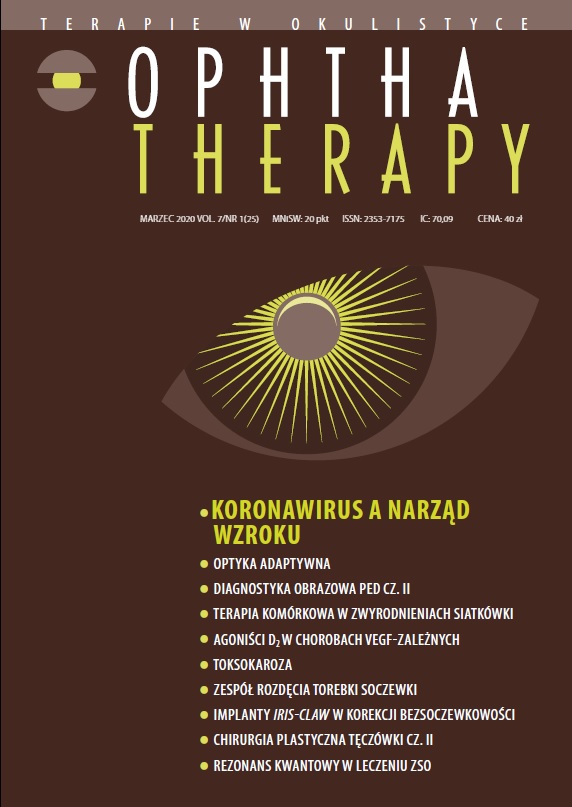Biomolecular quantum resonance in the treatment of dry eye disease Review article
Main Article Content
Abstract
Balancing the composition of tears and, consequently, restoring the homeostasis of ocular surface, is difficult to achieve. This is due to the complex composition of tears, the variety of secretory glands involved, as well as complex and not fully understood interactions affecting the composition, quality, and quantity of tears. The application of Biomolecular Quantum Resonance technology Rexon EyeTM (Resono Ophthalmic, Italy) is based on providing quantum (portions) of high-frequency electromagnetic energy (4–64 MHz) at low power whose interaction with the transport of ions, proteins of cell membranes, and cells changes cell performance. The use of new technology in the treatment of dry eye syndrome combines existing applications of Biomolecular Quantum Resonance such as surgery, treatment of wounds, treatment of bone fractures, as well as treatment pain.
Downloads
Article Details

This work is licensed under a Creative Commons Attribution-NonCommercial-NoDerivatives 4.0 International License.
Copyright: © Medical Education sp. z o.o. License allowing third parties to copy and redistribute the material in any medium or format and to remix, transform, and build upon the material, provided the original work is properly cited and states its license.
Address reprint requests to: Medical Education, Marcin Kuźma (marcin.kuzma@mededu.pl)
References
2. Tah V, Saha K, Myerscough J et al. Dry eye – An Insight into Meibomian Gland Dysfunction. Ophthalmology – Current Clinical and Research Updates 2014; 7: 155-75.
3. Tomlinson A, Bron AJ, Korb DR et al. The International Workshop on Meibomian Gland Dysfunction: Report of the Diagnosis Subcommittee. Invest Ophthalmol Vis Sci. 2011; 52(4): 2006-49.
4. Craig JP, Tomlinson A. Importance of the lipid layer in human tear film stability and evaporation. Optom Vis Sci. 1997; 74: 8-13.
5. Blackie CA, Coleman CAE, Holland EJ. The sustained effect (12 months) of a single-dose vectored thermal pulsation procedure for meibomian gland dysfunction and evaporative dry eye. Clin Ophthalmol. 2016; 10: 1385-96.
6. Choi M, Han SJ, Ji YW et al. Meibum expressibility Improvement as a therapeutic target of Intense pulsed Light treatment in Meibomian Gland Dysfunction and Its Association with Tear Inflammatory Cytokines. Sci Rep. 2019; 9: 7648.
7. Xue AL, Wang MTM, Ormonde SE et al. Randomised double-masked placebo-controlled trial of the cumulative treatment efficacy profile of intense pulsed light therapy for meibomian gland dysfunction. Ocul Surf. 2020; article in press.
8. Herbold TM, Busse H, Uhlig CE. Bilateral cataract and corectopia after laser eyebrow [corrected] epilation. Ophthalmology. 2005; 112(9): 1634-5.
9. Carrim ZI, Chohan AW, Devlin HC. Iris damage and acute pigment dispersion following photo-epilation. Eye. 2006; 20(12): 1486-8.
10. Elkin Z, Ranka MP, Kim ET et al. Iritis and iris atrophy after eyebrow epilation with alexandrite laser. Clin Ophthalmol. 2011; 5: 1733-5.
11. Halkiadakis I, Skouriotis S, Stefanaki C et al. Iris atrophy and posterior synechiae as a complication of eyebrow laser epilation. J Am Acad Dermatol. 2007; 57: S4-5.
12. Yalçındağ FN, Uzun A. Anterior uveitis associated with laser epilation of eyebrows. J Ophthalmic Inflamm Infect. 2013; 3: 45-8.
13. Liu R, Rong B, Tu P et al. Analysis of cytokine levels in tears and clinical correlations after intense pulsed light treating meibomian gland dysfunction. Am J Ophthalmol. 2017; 183: 81-90.
14. Greiner JV Long-term (12-month) improvement in meibomian gland function and reduced dry eye symptoms with a single thermal pulsation treatment. Clin Exp Ophthalmol. 2013; 41(6): 524-30.
15. Greiner JV Long-term (3 Year) Effects of a Single Thermal Pulsation System Treatment on Meibomian Gland Function and Dry Eye Symptoms. Eye Contact Lens. 2016; 42(2): 99-107.
16. Cherekaev VA, Bekiashev AKh et al. Experience in using a molecular resonance coagulator in neurooncology. Zh Vopr Neirokhir Im. N N Burdenko. 2005; (3): 33-6.
17. Kaku S, lshii T, Hasegawa Y et al. Usefulness of Bipolar Forceps and Generator with High Frequency Technology for Point Coagulation and Tissue Adhesion. Curr Pract Neurosurg. 2008; 18(5): 617-24.

